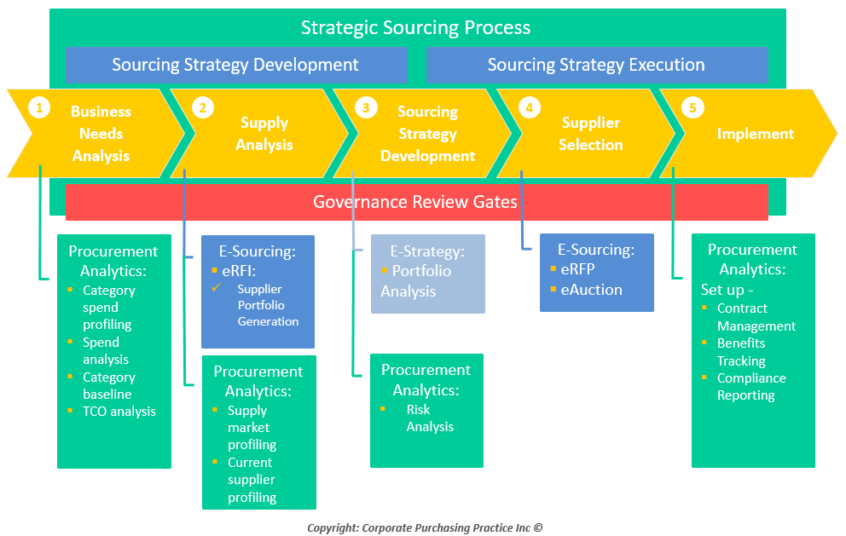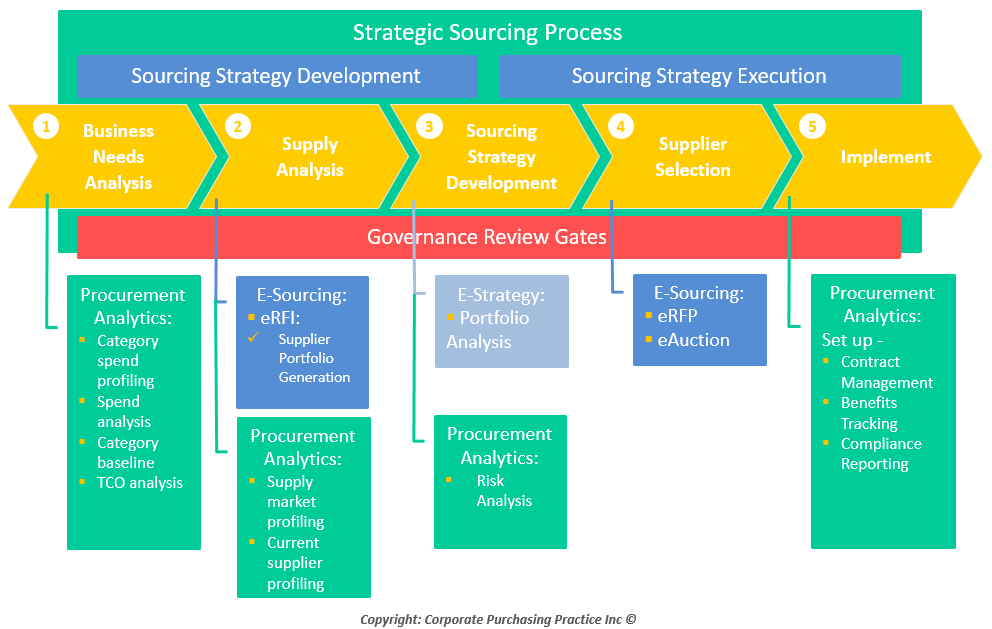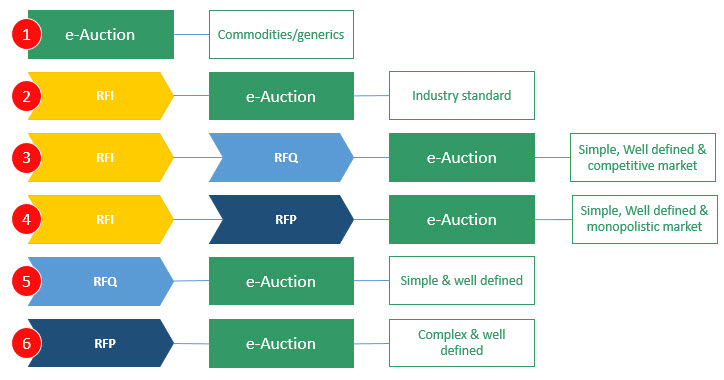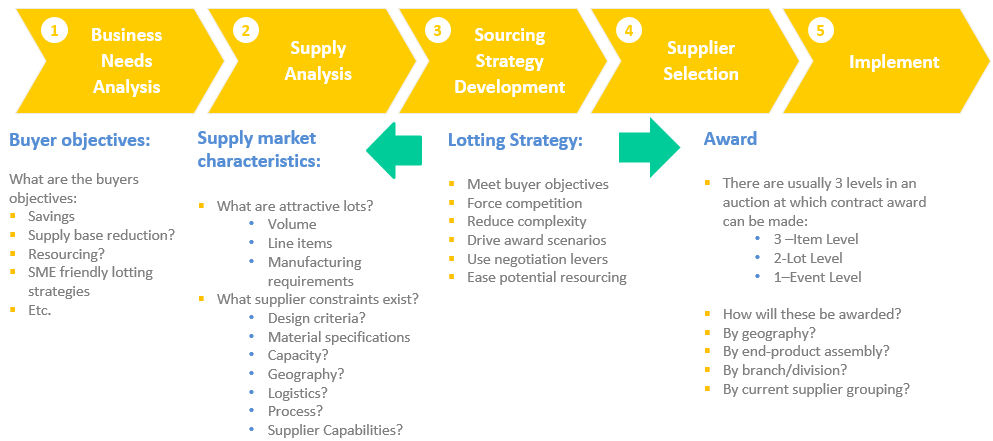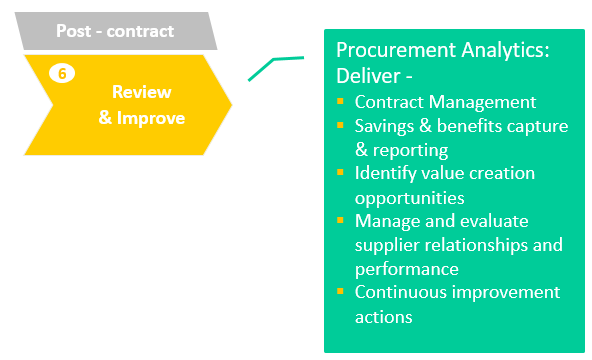Shape the agenda, deliver against strategic and tactical goals with e-enabled sourcing
Cost reduction is still one of the main drivers of e-enabled sourcing, but opportunities for competitive advantage also come from increasing spend visibility and reducing risk as well as improving supply chain responsiveness.
1. Introduction
E-Enabled sourcing has become a significant differentiator between leaders and laggards between today’s procurement organizations. While most organizations have moved towards P2P automation, such applications focuse only on tactical procurement processes via catalogs and shopping baskets. This capability can reduce purchasing transaction cost, but it does not help capture supply market opportunities and manage supplier relationships.
Category Management sets the strategy for procurement while strategic sourcing delivers the strategy into the business. Both are dependent upon effective company-wide approaches to:
- Analyzing spend
- Defining requirements
- Identifying and evaluating potential suppliers to who can meet needs and innovate
- Sourcing, negotiating and implementing contracts with selected suppliers
- Managing contracts and monitoring and improving supplier performance
e-enablement opportunities span the range of category management and strategic sourcing activities, including spend analysis, supplier risk analysis, RFI and RFP generation, e-auction and contract management and supplier performance management.
While, e-sourcing applications target strategic sourcing projects to drive significant savings and value. Procurement Analytics applications can drive automation and integration with any data source to provide a complete profile of supplier relationships via spend analysis, contract management, and supplier performance management.
2. The Size of the e-enabled Opportunity
To demonstrate the benefits we can take a typical company and use a simple metric such as cost savings. Keeping in mind that numbers will vary by industry, the concept is valid across industries.
2.1 Financial Benefits:
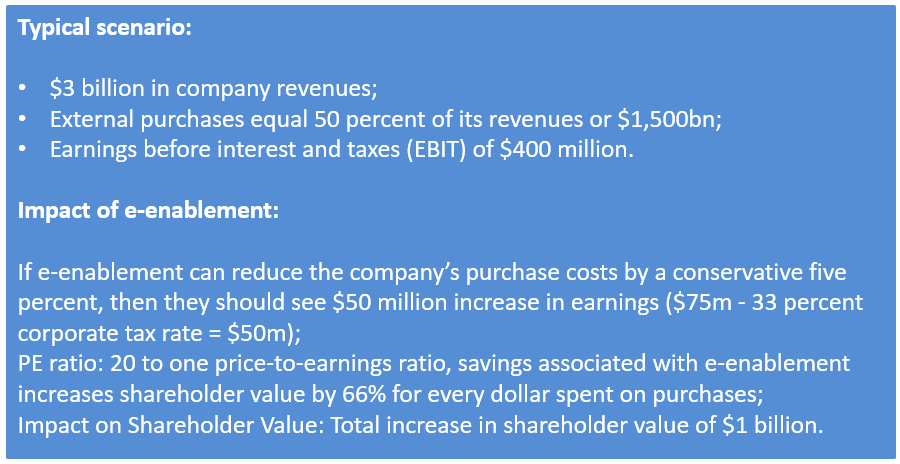
e-enabled sourcing delivers against capital markets expectations to drive increased shareholder value
In a second example for a company with $800m spend targeted for e-enablement:

e-enabled sourcing demonstrated the power and potential of procurement and sourcing role in the business
The second example shows e-enablement increased savings from 3% to 7% representing $32m. A massive 133% increase in savings performance alone.
2.2 More than cost savings:
In a wide variety of businesses, e-Enabled applications also:
- Increase transparency. A spend analysis tool allows users to “slice and dice” spend data to deliver meaningful information. Traditionally, such data has been derived from information within the ERP or accounts payable functions, but the quality of the outputs typically disappoints resulting in extensive further analysis in MS Excel. With a specialized Procurement Analytics tool unprecedented visibility and insights can be gained to support the development of category and sourcing strategies.
- Promote sourcing best practices. e-Sourcing applications create a centralized place to view and manage your sourcing activities and include documented processes and templates that facilitate the application of best practices.
- Stakeholder collaboration. e-Enabled sourcing applications are accessible to all appropriate stakeholders across departments, business units, and geographic boundaries. For example, an e-RFP can be generated by procurement and scored by stakeholders from across the business wherever they are. eRFPs also allow suppliers to ask questions and submit their bids online.
- Increase efficiency. e-Enablement speeds the ‘data to intelligence cycle’ to improve decision making and improved process flows. e-Sourcing tools facilitate a central workplace where legitimate stakeholders can view input data and monitor progress. Advanced spend analytics enables the capture of spend and volume data to monitor compliance, and e-sourcing tools can reduce sourcing cycle times by more than 25%.
- Improve sourcing decisions. The quality of a sourcing decision depends on the effectiveness of the analysis of business requirements and the supply markets ability to meet these. Procurement Analytics can assist this process to support the business case for the selected sourcing strategy. e-Enablement of data analysis and the sourcing process help drive optimum outcomes of sourcing events.
- Improve compliance. e-Enabled contract management tools help ensure; the realization of negotiated benefits, drives compliance with negotiated contracts, reduces “leakage,” while improved spend visibility facilitates compliance with the Sarbanes-Oxley Act.
- Improve supplier performance. e-Enabled supplier performance management allows the calculation of supplier performance against buyer generated scorecards.
3. Applying e-enablement in practice
All in all, e-Enabled spend analytics, sourcing, contract, and supplier management can help your organization build a stronger overall supplier base that is more responsive to innovation and changing economic conditions.
3.1 e-Enabled procurement analytics:
Sourcing initiatives should begin by analyzing the company’s spend. A product category analysis is needed to segment purchases into a workable number of differentiated groupings. Analytics can provide a detailed spend profile, capture market intelligence to provide a picture of the supply market, and business intelligence of current supplier performance to support sourcing strategy development.
3.2 Prequalify Suppliers
Use eRFI’s to screen suppliers. No more Excel spreadsheets or Word documents. Sourcing teams receive information from suppliers in response to submitted eRFIs, automated extraction of supplier data from external data sources such as Dun & Bradstreet, and internal data for suppliers you are already doing business with is automatically input into the supplier qualification process.
Procurement analytics can help collect sourcing data, and combine it in sophisticated ways to help sourcing teams rank potential suppliers.
3.3 Developing sourcing strategies
Your company’s competitive priorities — such as cutting costs, increasing innovation, and enhancing flexibility — will shape how external spend is managed. Development of best sourcing strategy to support these priorities will determine the and go to market approach selected.
3.4 Supplier selection
The use of e-sourcing provides a centralized view of all sourcing activities
Conduct eRFP’s and eAuctions. These days buyers can take advantage of the benefits of e-Enablement for most spend categories and have a range of sourcing options available to them. For example:
Generate, disseminate eRFI’s & eRFP’s, and receive supplier responses online. While eAuctions provide the ability to conduct negotiations over the Internet in real-time.
3.5 Shape and steer the negotiation
Buyers can capture a significant source of power by setting the bidding rules via the lotting strategy.
3.6 Manage Supplier Relationships
e-Enablement of supplier relationship management has at least as much benefit as the sourcing process itself.
Procurement Analytics enables buyers to:
- Mitigate risk. Increased visibility facilitates preemptive corrective actions and reduces the risk of costly supply-chain disruptions.
- Reduce costs. By quantifying the effect of late payment days, late delivery, faulty parts or missed SLAs on profit margins.
This data can be used to make the supply chain more efficient. - Quality improvements. Stakeholder Surveys on the quality of products/services can help improve the quality of supplier offerings.
- Dashboards. Link disparate data sources together to get a complete and accurate picture of the risks, costs and opportunities of partnering with suppliers. Integrated performance management of suppliers via central dashboard gives a 360 view of supplier performance including the scorecard results and KPIs.
- Improved collaboration. Is facilitated by improved relationships and rationalizing the supply base. Tight collaboration with the suppliers helps to identify risks and buyers can build performance scorecards in minutes to gather data quickly.
4. The implementation benefits are potentially massive:
Since every company must source and buy to stay in business, the activities discussed above should be recognizable to all business. Those who excel at these activities will gain a competitive advantage over their competitors who do not.
Most companies deal with thousands of suppliers, who may be responsible for more than 50% of the organizations value added activities. So optimizing the supplier base is one of procurements most important goals. E-enablement has become a significant capability in the battle to achieve this and ability to capture the value of e-enablement applications, has never been easier with the advent of cloud solutions:
4.1 Deployment:
Deploy applications real time – without having to purchase any software or hardware, reduce spending on technology infrastructure. Maintain easy access to your information with minimal upfront spending. People worldwide can access the cloud, provided they have an Internet connection;
4.2 Speed:
Today’s most successful businesses can gain a competitive edge because they can deal with change quickly and effectively. Access to the latest and greatest features for your business applications, makes workers more efficient and productive and massively reduces the decision-making cycle, and the process of deployment;
4.3 Scalability and Flexibility:
Most clients prefer to start small, prove value, then scale. In an on-premise environment, the whole business case needs to be developed before PoC and PoV!. In the cloud, you can change direction without serious “people” or “financial” issues at stake. Resulting in a dramatic increase in agility for the organization;
4.4 SWAP CAPEX for OPEX:
Because there is NO capital investment required with the cloud, you are drawing down the operating budget. So many clients are rightly tightening up their processes for approval of IT capital expenditures, and the shift to OPEX enables businesses to utilize valuable technology in a more cost-effective way;
4.5 Pricing:
Transparency in pricing and costs will reduce wasted spend ensuring that your payments match the value created for your service.
For businesses whose resources are limited these benefits are highly attractive allowing them to allocate and make smarter use of their resources.
5. Conclusion
Simply put, e-enablement has never been easier and claims of gaining a competitive advantage become a reality when the full potential is harnessed. E-enablement is now no longer the preserve of large corporations but is available to organizations of all sizes. It creates a compelling and highly strategic opportunity for improving the effectiveness of your procurement and increased supply chain performance. Now is the time to take action.
Nuff said …
If you would like to learn more about our e-enabled sourcing services you can learn more at CPP Procurement Cloud
or contact us to talk

